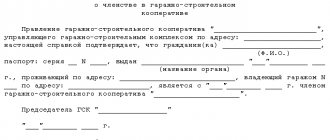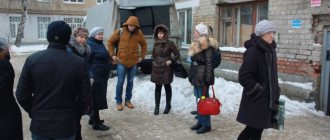If an interdepartmental commission indicates that, based on various parameters and characteristics, a house is considered unsafe, then life in it is dangerous for every person. Therefore, the municipal authorities are urgently taking various measures aimed at clearing such a structure. To do this, residents are evicted to other apartments or the purchase price of the property is transferred to them.
Dear readers! Our articles talk about typical ways to resolve legal issues, but each case is unique. If you want to find out how to solve your particular problem, please use the online consultant form on the right or call. It's fast and free!
Is it permissible to refuse relocation?
There are two choices for each owner of an object in an emergency building:
- studying the proposals of the regional administration, which offers new housing, and if it suits the citizen according to various indicators, then he can move to this property, and it may even be located in another city;
- if all the offers do not suit the owner of the apartment, then he can simply receive a redemption price for it, which involves buying the property out by the authorities.
Important! Often the redemption price is set correctly, so funds are issued that are sufficient to purchase other real estate on the market.
If the above options for solving the problem are not suitable for the owner of the premises, then the municipality may make concessions.
For this purpose, a larger apartment located in the same area as the emergency house may be offered. This helps speed up the relocation process.
But even in this case, the citizen can refuse, but the issue will be further resolved through the court. The administration files a claim against a specific citizen with a request to forcibly evict him.
The court always takes the plaintiff’s side, since living in a dilapidated house is dangerous and prohibited, so the resident will still have to make a decision.
What violations most often occur during relocation? Read the link.
With the help of the court
The court gets involved in resolving issues if the commission recognizes the housing as unsafe, which is why the property poses a real danger to the health and lives of people. This forces officials to force people to leave their apartments.
First of all, services are guided by the fact that their actions save the lives of other people. This process is usually resolved through the courts.
Find out about the procedure for eviction of citizens from non-residential premises. How to evict tenants with children without an agreement? Information here.
What are the grounds for eviction under the Housing Code of the Russian Federation? Details in this article.
Features of the program
Back in 2015, a special program was introduced, on the basis of which all people living in emergency apartments should be resettled by 2021, but this process was not implemented by the set date.
Is it possible to refuse relocation? Watch the story in this video:
Difficulties are caused by various factors:
- the municipal fund does not have a sufficient number of premises that could be used for the resettlement of citizens;
- Often municipal authorities have to independently engage in the construction of houses, and buildings with 20 floors are erected, and objects are also offered to residents in violation of living space standards per citizen;
- the procedure is complicated by the fact that people arbitrarily occupy living space that belongs to the municipality, and also do not agree to all the proposals and conditions of the authorities, so they have to go to court to forcibly evict the residents;
- if people illegally occupy municipal space, they are evicted without compensation or provision of another facility;
- Often, even after a court decision, people do not agree with the eviction, so they continue to occupy the living space, which leads to the need to open enforcement proceedings and forced eviction.
Important! Usually people refuse to move because they want to get premises taking into account the standards according to which at least 18 square meters must be allocated for each person. m.
Some regional authorities are simply not able to provide residents with such facilities, and an increase in space is offered only for people who were in line for an apartment before relocation.
How are queues and lists for obtaining housing formed? See the link.
Legislative regulation
The basic rules regarding the relocation of citizens from emergency housing are established in PP No. 47. This act states that it is permissible to evict residents only after the interdepartmental commission makes an appropriate decision, according to which the house is actually recognized as unsafe.
Information from Art. 89 of the Housing Code, which states that if a municipal house is being moved out, then residents must receive housing that will have the same square footage as their previous apartment.
Article 89. Providing citizens with other comfortable residential premises under a social tenancy agreement in connection with eviction
1. Provided to citizens in connection with eviction on the grounds provided for in Articles 86 - 88 of this Code, another residential premises under a social tenancy agreement must be well-equipped in relation to the conditions of the relevant locality, equivalent in total area to the previously occupied residential premises, meet established requirements and located within the boundaries of a given locality. In cases provided for by federal law, such provided residential premises, with the written consent of citizens, may be located within the boundaries of another populated area of a constituent entity of the Russian Federation, on the territory of which the previously occupied residential premises are located. In cases provided for by federal law, citizens who are registered as needing residential premises or have the right to be registered are provided with residential premises according to the provision standards.
2. If the tenant and his family members living with him before eviction occupied an apartment or at least two rooms, the tenant accordingly has the right to receive an apartment or to receive living quarters consisting of the same number of rooms in a communal apartment.
3. The residential premises provided to a citizen evicted by court must be indicated in the court decision on eviction.
Resettlement program by year. Photo: static1.repo.aif.ru
Under what conditions is resettlement carried out?
This process is carried out under the following conditions:
- it is necessary to carry out major repairs in the house;
- the building is recognized as unsuitable for further use as a place for people to live;
- the building is in disrepair and therefore must be demolished;
- the land located under the house is seized for various purposes of the state or municipality.
All conditions can be read in PP No. 47.
Is it possible to refuse?
There are times when, for one reason or another, people do not agree to move to a new home.
The owner is not obliged to follow the lead of the government and management organizations, since based on the latest adjustments in regulations that were issued back in 2015, a person has several options:
- not agree to move to a new property;
- alternatively, demand financial compensation equal to the value of your property according to market rates.
In the latter case, the money is paid by the city local authorities, and the owner of the apartment manages it directly, and here the state does not restrict it in any way.
The overwhelming majority of management organizations do not take the best approach to a person’s refusal of the property offered to him.
Can tenants refuse to be relocated?
Citizens have the opportunity to refuse the purchase price and the proposed housing, but municipal authorities will be forced to go to court.
Usually the court forces the forcible eviction of citizens, since they are not allowed to live in an emergency facility. However, relocation depends on whether people are renters or owners.
How do tenants relocate?
If people lived in an emergency building on the basis of a social tenancy agreement, then a new apartment will be provided taking into account the standards prescribed in Art. 86 LCD.
Article 86. The procedure for providing residential premises under a social tenancy agreement in connection with the demolition of a house
If the house in which the residential premises occupied under a social tenancy agreement is located is subject to demolition, the citizens evicted from it by the state authority or local government body that made the decision to demolish such a house are provided with other comfortable residential premises under social tenancy agreements.
Important! The area of the proposed premises cannot be less than the square footage of the previous apartment.
The tenant can count on even larger living space if he is registered accordingly. In this case, he may be offered a subsidy towards the purchase of housing.
How do owners move?
How does the relocation of owners take place? Photo: 77metrov.ru
If the premises belong to a person by right of ownership, then he can choose one of the options:
- provision of a new premises that is of high quality and comfortable, and its size must be identical to the square footage of the previous apartment, and there must also be the same number of rooms;
- if a person was previously registered, on the basis of which he needed improved housing conditions, then he will be given a more comfortable and larger apartment, which in square footage exceeds his previous living space, but this housing is issued on the basis of a social lease agreement, and also in the future he will not be able to get it privatize;
- receiving the redemption price on the basis of Art. 32 ZhK and Art. 281 of the Civil Code, since apartment owners can refuse the proposed objects if they are not satisfied with them in any way.
Article 281. Compensation for seized land
1. For a land plot seized for state or municipal needs, its owner is provided with compensation.
2. When determining the amount of compensation for the seizure of a land plot for state or municipal needs, it shall include the market value of the land plot, the ownership of which is subject to termination, or the market value of other rights to the land plot subject to termination, and losses caused by the seizure of such land plot , including lost profits, and determined in accordance with federal legislation.
If, simultaneously with the seizure of a land plot for state or municipal needs, real estate objects located on such a land plot and belonging to the right holder of this land plot are seized, the compensation for the seized property includes the market value of the real estate objects, the ownership of which is subject to termination, or the market value of other rights to real estate subject to termination.
3. If there is the consent of the person from whom the land plot is being seized, the agreement on seizure may provide for the provision to this person of another land plot and (or) other real estate on the terms and in the manner determined by law, with the cost of such land plot offset and (or) other real estate or rights to them in the amount of compensation for the seized land plot.
4. Forced seizure of a land plot for state or municipal needs is permitted subject to prior and equivalent compensation.
Important! The redemption price is determined depending on the market value of the property, and the wear and tear of the building is also taken into account.
Procedure for eviction of owners from emergency housing
The law establishes a certain procedure for residents to vacate buildings unsuitable for habitation. The owner has the right to use one of several options offered by the state when eviction:
- Getting a new home instead of the previous one.
- Receiving a cash ransom - an amount equal to the market value of the previous home.
It is important to note that the purchase price includes not only the actual price of the apartment, but also all losses associated with the vacancy of the territory and relocation to a new building.
If a government agency refuses to pay the owner of the premises a sum of money to compensate for the cost of housing upon eviction, the owner has the right to go to court. Judicial practice in similar cases contains many decisions satisfying the owner’s claims.
The housing offered to the owner during the eviction process to replace the unsafe one must meet a number of requirements:
- The premises must be located within the same locality.
- The premises must have an area and number of rooms equal to the area and number of rooms in the previous apartment.
During the process of eviction from a dilapidated building, the owner may be offered premises in a new building or secondary housing stock.
The owner’s refusal to vacate the premises makes the process of eviction and subsequent measures with the unsafe building impossible. In practice, government agencies often offer the owner more favorable housing conditions compared to the past, if both parties to the legal relationship agree to such conditions. Issues of vacating a building and the subsequent acquisition by a citizen of a home must be resolved between the owner and the government agency, and any disagreements that arise are resolved by the court.
The nuances of obtaining other housing
According to Art. 87 and art. 89 LCD, when resettling people living in a dilapidated building, they are offered other apartments, which must have the same area as the previous living space.
Article 87
If residential premises occupied under a social tenancy agreement are subject to transfer to non-residential premises or are recognized as unsuitable for habitation, the landlord provides citizens evicted from such residential premises with another comfortable residential premises under a social tenancy agreement.
This option is chosen for all people living in apartments on the basis of a social tenancy agreement. It is possible to obtain a higher quality and larger apartment if the tenant was previously registered so that he would be given a better quality living space.
Important! The facilities provided must be well-maintained, suitable for living and of high quality, and for certain citizens the standard for all family members is taken into account, so there should not be less than 18 square meters per person. m.
If housing is offered that does not correspond to the previous quadrature, then tenants can file a lawsuit, and usually the courts side with the plaintiffs, so municipal authorities undertake to find optimal housing for citizens.
How is communal apartments resettled? Features and legislative framework here.
WHAT IS THE PROCEDURE FOR RECOGNIZING HOUSING AS UNCONDITIONAL?
The current legislation has rules and regulations according to which housing is recognized as unsafe.
Thus, after contacting the competent authority with the necessary package of documents, a commission consisting of the following persons is assembled:
- Representative of local government bodies;
- Specialists of design organizations and institutions appointed by sanitary and epidemiological supervision in regional departments;
- Fire and environmental services employees;
- Representatives of the Consumer Rights Protection Committee;
- Architects and urban planners.
Specialists from organizations and institutions involved in design, or the owners of the premises themselves, can also be involved. In the case of participation in the commission of owners, the above-mentioned have only the right of an advisory vote.
The commission, based on the documents provided, makes decisions within 30 days on the suitability of the premises for habitation, the degree of accident, the need for reconstruction, redevelopment, complex repairs or demolition of the house, or the possibility of reconstructing the premises.
Next, an order and conclusion are drawn up and approved, which are submitted by the applicant within five days.
Specifics of purchasing apartments
Residents of such a building can, instead of apartments, receive a redemption price represented by compensation for the property.
Refusals to relocate from emergency housing? Watch the video:
During its calculation, various important points are taken into account:
- market price of the object;
- expenses that owners will have to bear to move;
- expenses for registration of ownership of new housing;
- lost profits, since obligations on the apartment are terminated by citizens ahead of schedule.
To receive the redemption price, the municipal authorities must draw up an appropriate agreement with the residents. It indicates the price transferred to citizens. The residents themselves must agree to the price, so if they do not agree with its size, they can file a lawsuit.
Also, if residents refuse to receive apartments or the redemption price, the municipality will also file a statement of claim, on the basis of which it is required to forcibly evict citizens.
Therefore, residents of a dilapidated building independently choose whether they will receive a new apartment issued by the municipality, or whether they will receive a ransom for their housing, used for any purpose.
There is no requirement to report to municipal authorities as to where exactly the ransom money will go.
WHAT DO RESIDENTS BELIEVED AFTER THE HOUSING IS RECOGNIZED AS UNCONDITIONAL?
As soon as the property has been declared unsafe, the residents have the right to improve their living conditions.
Then you can go one of three ways. The first way is that persons applying for the right to improve their living conditions must wait for resettlement under the federal program. The second way is to wait for the provision of new housing at the expense of the local government. Well, the third way is for a person to file a lawsuit and initiate the receipt of comfortable housing.
What kind of housing is considered unsafe?
The criteria for assigning this status to buildings are set out in Government Decree No. 47. It is important to understand that, first of all, safety issues for the life and health of citizens living inside the house are taken into account. Attention is paid to two factors:
- the condition of the structure itself. We are talking about both banal wear and tear of structures and accidents that have occurred;
- environmental parameters of the space surrounding the house. Changed climatic conditions, concentration of harmful substances, etc. may be unacceptable.
Taking into account the condition of the housing according to these two indicators, inspection authorities may declare the building unfit for habitation in the following cases:
- the building in which the apartment is located is recognized as unsafe and subject to demolition due to deterioration of the structures;
- sanitary and epidemiological standards of the surrounding area have been violated. Living in such an environment affects people's health;
- the building is located in the path of potential avalanches, flooding, landslides or mudflows. When it is impossible to prevent these phenomena from engineering or reduce the damage they cause to zero, the house must be resettled;
- the housing is located in an area of possible man-made disaster or near high-voltage lines;
- houses were damaged as a result of accidents of any origin and their repair is impossible or impractical;
- The reason for the house to move could be the construction of a busy highway next to it, which is why the noise level in the room exceeded all permissible standards.
Attention! Each specific criterion described above has a technical description. We are talking about volume, measured in decibels or the industrial power of the electric field created by high-voltage lines, etc. Each specific case is subject to expert assessment and conclusion.
However, there are exceptions when buildings are not recognized as unsafe and are not subject to resettlement:
- multi-storey buildings with no elevator and non-functioning garbage chute, even if the necessary mines are available;
- low-rise buildings with no hot water supply or access to sewerage;
- if the previously built housing met the standards in force at that time (distance from the bathroom to the kitchen, size of the doorway, etc.), but does not comply with the new ones. The law does not have retroactive effect.
Of course, each case is individual and the decision on the need for resettlement is made, as a rule, jointly, through negotiations between an initiative group of residents, local authorities, utility workers, etc. From the general recommendations it follows that housing begins to be recognized as unsafe from the moment when the deterioration of structures is at least 70%.
How does resettlement occur if housing is privatized?
This process is regulated by law, specifically by Articles No. 32 and No. 35 of the Housing Code. Citizens whose housing must undergo major repairs or be completely demolished should remember the following nuances:
- an apartment located in a dilapidated building is purchased from the owner at the expense of the local authorities;
- the total amount of compensation will include the market value of housing, as well as any other costs associated with inconvenience during relocation;
- The owner can, if he wishes, apply not for monetary compensation, but for equivalent housing. He may also receive housing of worse quality and part of the compensation “from above”;
- the owner can choose to reconstruct the building or undertake to demolish it himself (with financial support from the municipality). To do this, you must notify the authorities no later than 6 months after receiving the notification;
- If the owner of the property does not agree with the eviction, then he can be forced to do so only by a court decision.
Municipal authorities responsible for the demolition and obliged to carry it out on time according to the plan can apply to the judicial authorities. Before deciding whether it is possible to evict a tenant from a privatized apartment or not, the court must obtain evidence that he has received the required monetary compensation.
Attention! Reimbursement of the cost of the apartment must be carried out strictly before eviction, because owners of privatized apartments need to independently look for housing to replace the old one, and doing this without money will be simply impossible.
The amount of this compensation is calculated by adding the following values:
- the actual cost of the apartment, including part of the common property that belonged to it;
- costs of moving to a new location;
- payment of rent for temporary rental housing;
- reimbursement of expenses associated with the search for new housing, its purchase, paperwork, etc.;
- penalty or so-called compensation for lost profits that the owner could have received by renting out an apartment in an old building.
As stated above, recently, owners of privatized housing, in accordance with Article No. 89 of the Housing Code, may be provided with other housing instead of the old one or as an addition to the cash payment.
The procedure for providing other comfortable living quarters
Providing housing to citizens in connection with eviction is a forced measure for municipal authorities, so it will not be possible to improve their living conditions at the expense of the budget. The new apartment is provided with the same total area as the existing one; the standards per person in this case do not in any way affect the size of the housing provided to replace the damaged or dilapidated one.
If housing is recognized as unsafe after a catastrophe or natural disaster, the provision of other housing should be done as quickly as possible. In particular, the decision of the special commission must be made within 5 days after receiving an application from the owners. New housing must meet the characteristics already described - be well-equipped, no smaller in size and located in the same city.
Arbitrage practice
The main disputes related to the relocation of citizens from dilapidated or dilapidated housing concern issues of the amount of compensation, total area, new living conditions, and so on. Programs for the provision of new housing and major repairs have only been in effect for a few years, so the practice has not yet been fully developed. In addition, in the case of compensation, their payment can be extended over several years, which is also not always convenient for residents, so they often file various claims against the administration.
When filing counterclaims for housing, it is recommended to turn to professionals, since the field of real estate and the procedure for carrying out transactions with it is a specific branch of law in which it is necessary to have certain knowledge and skills. It should also be borne in mind that, in accordance with the Housing Code, it is the responsibility of the owners to monitor the legality of the actions of municipal authorities in terms of operations with dilapidated and dilapidated housing. If necessary, actions or inactions of government bodies can be appealed, but again this must be done by the residents themselves.
Thus, relocating owners from dilapidated and dilapidated housing is a rather labor-intensive process. You should clearly know your rights and be able to defend them. In particular, do not allow the provision of housing under a social tenancy agreement (the premises should only be provided as private property, and with similar characteristics), be able to calculate the amount of compensation in case of refusal to move to the proposed apartment, and so on. It should be remembered that a stable judicial practice of residential eviction claims has not yet been formed, so if problems arise, you should not be afraid to turn to professionals.






![Mortgage for civil servants and other public sector employees in Sberbank in [year]](https://2440453.ru/wp-content/uploads/ipoteka-dlya-gossluzhashchih-i-drugih-byudzhetnikov-v-sberbanke-v-year4-330x140.jpg)



